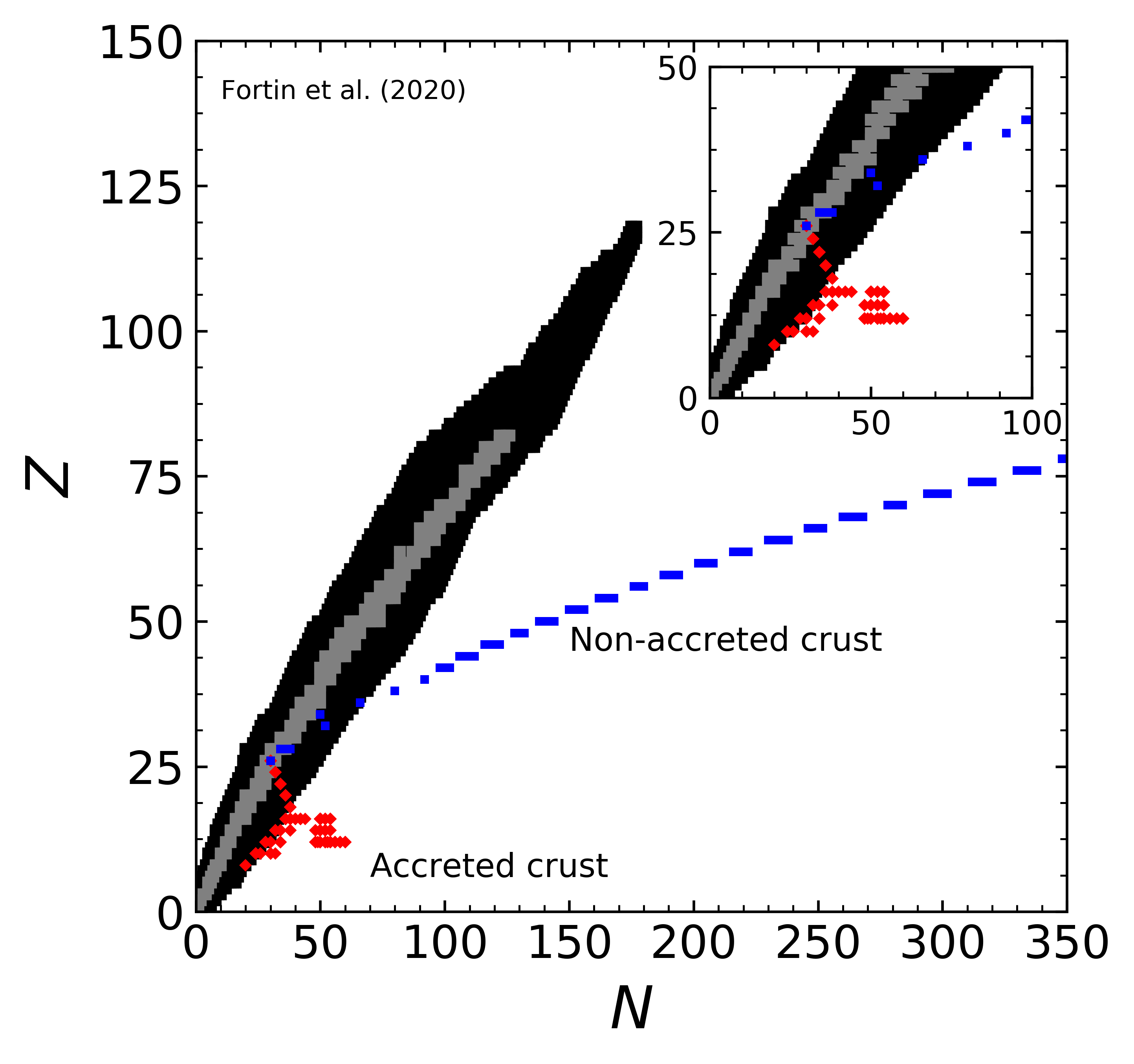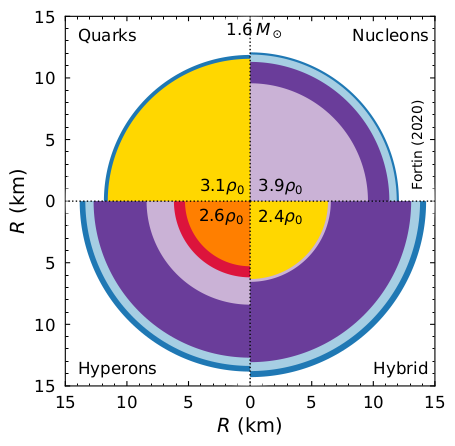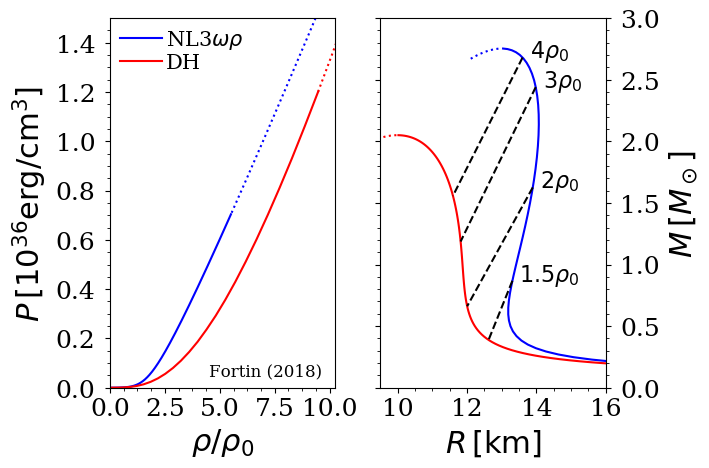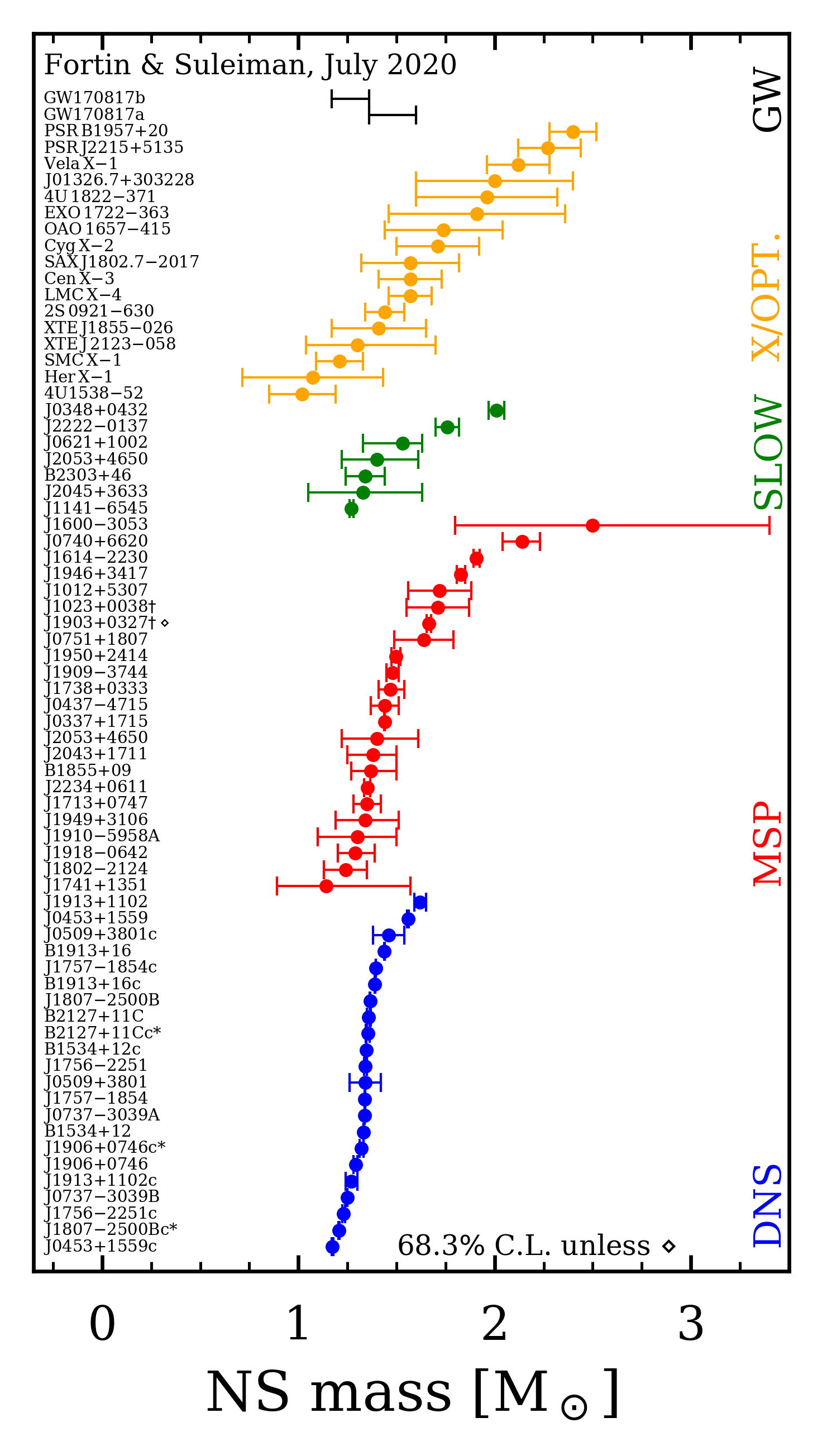Farewell
Sept. 30, 2020 marks my last day as an astrophysicist and an academic. I have taken the decision to shift to the private sector and to the field of data science in particular. My data science website can be found here.
Should you need to contact me, you can still reach me for some more time on my CAMK address fortin@camk.edu.pl. I also encourage you to contact my collaborators and co-authors (see the presentation section).
I wish my colleagues and friends all the best for their future research and I am sure they will find out more about the properties of neutron stars in the near future thanks to the many existing and future multimessenger observatories.
Latest
- I have been elected to the Scientific Council (Rada Naukowa) of my institute, N. Copernicus Astronomical Center, representing scientific employees with a PhD and before habilitation;
- I was interviewed for the popular website Science News to comment on the consequences for neutron star physics of the results of a Nature Physics paper. The latter reports among other things a new measurement of the properties of the hypertriton, an hypernucleus, composed of a neutron, a proton, and a $\Lambda$ hyperon.
- I am in charge of updating the content of the popular book Grand Guide de l'Astronomie (Éditions Glénat) (in French) for its new edition which was published at the end of June 2020 (available here/disponible ici). Previously I updated the Grand Atlas de l'Astronomie (Éditions Glénat) (in French) released in December 2019 (available here/disponible ici);
- I am a member of the Scientific Organizing Committee of the PHAROS annual conference 2020 "The multi-messenger physics and astrophysics of neutron stars".
- I took part in a debate organized by the Institut Français in Warsaw to discuss about life of Mars and in the Universe during the 2020 Nuit des Idées (pictures here);
- I gave an invited talk entitled "Constraints on neutron star properties" at the PHAROS WG1+2+3 meeting;
- I was a member of the Scientific Organizing Committee of the ICONS workshop 2019 "Investigating Crusts of Neutron Stars", the PHAROS annual conference 2019 "The multi-messenger physics and astrophysics of neutron stars", and the 2019 EWASS Special Session "Neutron stars as multi-messenger laboratories for dense matter physics";
- I gave lectures about the neutron star equation of state at the PHAROS PhD training school. The slides can be found here;
- Within the EU-funded NewCompStar network, I among other things got interviewed for the video, contributed to the brochure presenting the action, translated it to French and to the animation movie about the "Formation and Evolution of Binary Neutron Stars", three realizations that were made to mark the end of action.
Presentation
I am an astrophysicist employed as a postdoc (adiunkt) at N. Copernicus Astronomical Center (a.k.a. CAMK in Polish) of the Polish Academy of Sciences, in Warsaw (Poland).
My current project entitled "From models of the core and crust of neutron stars to observations of pulsars and X-ray sources" (2017/26/D/ST9/00591) is supported by a three-year Sonata grant from the Polish National Science Center for the period 2018-2021.
My current research interests include the theoretical study of various aspects of the physics of neutron stars at the crossing between nuclear physics and astrophysics while always making the connection with multi-messenger astronomical observations and nuclear experiments. For the moment I focus in particular on the following aspects:
- Equation of state of neutron stars - what are neutron stars made of?
- Hyperons in neutron stars - are strangeness-bearing particles present at the center of massive neutron stars?
- Thermal evolution of isolated and accreting neutron stars - how does the temperature inside neutron stars (isolated or in a binary system with a companion star) evolve?
My list of publications can be found on NASA-ADS or using my ORCID number  0000-0002-9275-3733.
0000-0002-9275-3733.
I have the chance to collaborate with many scientists around the world, in particular:
- Constança Providência, Marcio Ferreira, Violetta Sagun and Helena Pais, Coimbra University (Portugal);
- Paweł Haensel, Julian Leszek Zdunik and Lami Suleiman, CAMK Warsaw (Poland);
- Isaac Vidaña, INFN Catania (Italy);
- Adriana R. Raduta, IFIN-HH (Romania);
- Sidney Avancini, Federal University of Santa Catarina (Brazil);
- Bijay Agrawal and the members of his group, Saha Institute of Nuclear Physics (India);
- Dmitry Yakovlev and the members of the neutron star group, Ioffe Institute (Russia);
- Micaela Oertel and Jérôme Novak, Paris-Meudon Observatory (France).
I am and have been involved in various international projects such as:
- the UE-funded COST action CA16214 PHAROS (2018-2022) "The multi-messenger PHysics and Astrophysics of neutROn Stars" as the Task Leader in charge of nuclear physics in the Working Group 3 "Gravitational wave signals in neutron stars" and as a substitute representing Poland in the management committee;
- the UE-funded COST action MP1304 NewCompStar (2013-2017) "Exploring fundamental physics with compact stars".
- the Athena X-ray observatory collaboration as a member of the Working Groups: "End points of stellar evolution" and "Physics of Accretion".
I am a member of the Polish Astronomical Society (Polskie Towarzystwo Astronomiczne) and of the European Astronomical Society.
In 2018, I organized POLNS (pronounced as polonaise) the first conference gathering scientists (50+ participants) working in Poland on all aspects of neutron stars, such as multimessenger astronomy, physics of dense matter, and relativistic nuclear astrophysics.
CV
 I got my PhD in 2012 within the framework of a Polish-French cotutelle. I shared my time between CAMK and LUTh, Paris-Meudon Observatory working under the supervision of Julian Leszek Zdunik in Poland and Eric Gourgoulhon in France. I then obtained both Polish and French Ph.D. titles (Dr.2?).
I got my PhD in 2012 within the framework of a Polish-French cotutelle. I shared my time between CAMK and LUTh, Paris-Meudon Observatory working under the supervision of Julian Leszek Zdunik in Poland and Eric Gourgoulhon in France. I then obtained both Polish and French Ph.D. titles (Dr.2?).
Before that I studied physics and astrophysics at École Normale Supérieure in Paris and at Paris-Meudon Observatory.
My full CV with a list of talks and seminars I gave can be found here (updated in March 2020).
A short introduction to my research topic
See the slides of the lecture I gave at the PHAROS PhD training school for more details, plots, and references.
Neutron stars (NSs) are born in the supernova explosion that marks the end of the life of stars with a mass around 10 to 30 times the one of the Sun. So far about 3000 NSs have been observed with radio, infrared, optical, UV, x-ray, and gamma-ray telescopes and gravitational wave detectors.
With a radius of about 12 kilometers and a mass of the order of 1 to 2 solar masses, NSs are one of the densest forms of matter in our Universe: the average density inside them is a couple of times larger than the average density inside heavy atomic nuclei. Their structure and dynamics are ruled by General Relativity. In gravity is counterbalanced by the nuclear forces acting between the particles present in their interior. The properties of the nuclear interaction at densities significantly higher than that of nuclei are mostly unconstrained and thus many models for it have been proposed.
Neutron star and matter on Earth
 Figure in eps and png formats.
Figure in eps and png formats.
As their name indicates, NSs are mostly composed of neutrons, which are in the interior ten times more numerous than protons, contrary to our matter on Earth, where numbers of protons and neutrons are roughly equal.
The outer part of NSs, called the crust, consists of nuclei immersed in electron and neutron gases. The figure shows the number of neutrons $N$ and of protons $Z$ all nuclei produced in laboratory, in black, and in color, nuclei predicted in the crust for a given nuclear model. Most of the nuclei expected in the crust contain many more neutrons than ones produced in accelerators. Hence most of the matter composing NSs can not be produced and examined on Earth. In other words NSs are a unique "cosmic laboratory" to study nuclear physics in ranges of densities and temperatures not reachable in terrestrial accelerators. The properties of the matter inside NSs and the composition of their interior in particular in the NS core, the innermost part, are still poorly known.
What is inside a neutron star?
 Figure in eps and png formats.
Figure in eps and png formats.
The figure shows shows the structure of a NS with a mass of 1.6 times the one of our Sun for four examples of models of the core.
A NS is composed of two parts: the crust, in blue in all models, and the core. Some models predict that only nucleons - neutrons and protons - are present in the core (SLy4, top right), others that the core is only made of deconfined up, down and strange quarks (SQM1, top left), or that hyperons - particles with a strange quark - appear deep inside the core (DDME2, bottom left) or lastly that the core is an hybrid, where quarks replace nucleons in the very center (NL3$\omega\rho$, bottom right). The central density for each model is indicated in terms of $\rho_0$, the average density inside heavy nuclei.
Equation of state $\&$ neutron star mass and radius
 Figure in eps and png formats.
Figure in eps and png formats.
The left plot of the figure shows for two models of the neutron star interior taken from Fortin et al. PRC (2016) the equation of state (EoS) that is the relation between the pressure $P$ inside the star and the density $\rho$ (here expressed in terms of $\rho_0$ the average density inside heavy nuclei). Each model of the nuclear interaction is characterised by a given EoS.
For a given EoS and value of the density at the center of the star one can solve the so-called Tolman-Oppenheimer-Volkoff equations for hydrostatic equilibrium in General Relativity and obtain the mass $M$ and radius $R$ of a NS. By then varying the value of the central density, one can obtain the so-called $M-R$ relation which is characteristic of a given EoS. Such relations are shown on the right plot for the two EoSs of the left panel. Each point of a given $M-R$ curve corresponds to a specific NS configuration that is a given central density, mass and radius. The NS mass and radius obtained for different central densities are shown by the black dashed lines. As the central density increases the mass also increases up to the point where it reaches a maximum value $M_{\rm max}$. Then the mass decreases with the density (dotted part of the $M-R$ relation): this corresponds to NS configurations that unstable with respect to small perturbations and that would collapse and form a black hole. Hence no NS exists on this unstable branch. The part of the EoS which corresponds to this unstable branch is also plotted with a dotted line on the left panel. Each EoS has a given maximum mass Mmax which has to be larger than the mass of the heaviest observed NS; otherwise the EoS is not compatible with the existence of such a massive NS and thus it can be ruled out.
Neutron star masses
 Figure in eps and png formats.
Figure in eps and png formats.
This figure made in collaboration with Lami Suleiman (Ph.D. student at CAMK) shows the current measurements of NS masses.
Classification:
- DNS: double NS systems - the symbol $*$ indicates that the nature of the companion star is unclear: NS or massive white dwarf (WD);
- MSP: millisecond pulsars: NSs, not in a DNS, with a rotation period $P\le$20 ms (spin frequency $f\ge$50 Hz) (the symbol $\dagger$ indicates that the companion star is a main-sequence star, unlike for the other systems for which it is a WD);
- SLOW: slowly rotating NSs ($P\ge20$ ms or $f\le50$ Hz), not in a DNS system;
- X/OPT.: NSs for which the mass was measured using X-ray or optical observations (while radio timing was used for the other NSs);
- GW: NSs for which the mass was measured from the detection of gravitational waves. So far this has been possible only for the first ever binary NS merger observed: GW170817. The plotted masses were obtained under the low spin assumption.
$68.3\%$ confidence level except for PSR J1903$+$0327: $99.7\%$ ($\diamond$ symbol) and GW170817.
Neutron star equation of state $\&$ mass-radius measurements
 Figure in eps and png formats.
Figure in eps and png formats.
In the figure the relation between the neutron star mass in units of the mass of the Sun and radius in kilometers for various models of the nuclear forces and composition of the core are shown: quark core in yellow, only nucleons in violet, with hyperons appearing inside the core of massive stars in red and with a hybrid composition of a quark phase surrounded by a nucleonic one in green. The horizontal grey strips represent the precisely-determined masses of the lightest and heaviest neutron stars observed so far. The orange ellipsoid shows the constraints obtained on the mass and radius of the neutron star J0030+0451 by the NICER satellite currently operating onboard on the International Space Station. The Athena satellite which will be launched in the years 2030s is expected to provide accurate measurements of the radius (with a 5% precision). Each nuclear model predicts a maximum mass which is required to be larger than the mass of the heaviest observed neutron stars in order to be consistent with observations. As the maximum mass for the BSk19 nuclear model (dotted line) is smaller than the one of the very heavy neutron star J1614$-$2230, this model can be ruled out. The TM1 model (dashed line) can also be excluded as it is not consistent with the properties of matter for densities smaller than the ones in nuclei, measured using accelerators on Earth. The blue area covers ranges of mass and radius obtained for nuclear models that are consistent with nuclear experiments on Earth and astrophysical observations at the same time. The red striped-area shows the uncertainty on the mass and radius of stars with hyperons in the core due to the fact that the properties of these particles are barely constrained by laboratory measurements. The detection by the LIGO-Virgo collaboration of gravitational waves emitted during the merger of two neutron stars GW170817 puts additional limits on the radius allowing to rule out some nuclear models and thus further constrain the properties of the nuclear interaction.
In the last few years constraints on the radius of a few NSs have been obtained with X-ray observations and gravitational wave detections. Combined with laboratory measurements, these already allowed to rule out some models for the nuclear interaction. More precise and numerous radius measurements and constraints are expected in the next decade with sensitive X-ray telescopes like NICER and Athena and the gravitational wave detectors of the LIGO-Virgo-Kagra collaboration.
- I develop theoretical models for the interior of neutron stars taking into account as much experimental data on nuclei and nuclear matter as possible;
- I model various neutron star properties, such the mass and radius, … and processes taking place inside and around neutron stars;
- I confront the results of my calculations to constraints obtained from multi-messenger astrophysics and experimental nuclear physics.